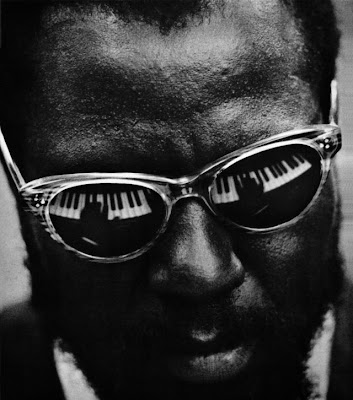
I absolutely recommend listening to the full albums of any of the artists that I post, each song is not just a lonely single, they all belong to thoroughly complete and worthwhile albums. However, I'm not always constrained by this fancy, and I'm well aware that music listening doesn't necessitate full album experiences. But when possible I certainly enjoy a good album more than wanderings through genres and influences. Here are some fully immersible albums: (I have some categorized, but some are beyond my categorical capacity)
Strunz & Farah: Desert Guitar (Flamenco/Persian Guitar)
Paul Chambers: Bass On Top (Bass Heavy Jazz)
Portugal. The Man: Censored Colors
The Black Keys: Chulahoma (Blues)
Beats Antique: Collide (World Fusion Electronica)
The Seatbelts: Cowboy Bebop (Jazz)
TV On The Radio: Dear Science
Daft Punk: Discovery (Electronica)
Easy Star All Stars: Dub Side Of The Moon
Pink Floyd: Dark Side Of The Moon
Yusef Lateef: Eastern Sounds (Jazz)
Pretty Lights: Filling Up The City Skies (Electronica)
Cut Copy: In Ghost Colors (Electronica)
Neutral Milk Hotel: In The Aeroplane Over The Sea
Justice: Justice (Electronica)
Led Zeppelin: Led Zeppelin I
The Jimi Hendrix Experience: Axis Bold As Love
Living Legends: Legendary Music Vol. 1(Hip Hop)
Béla Fleck & The Flecktones: Live At The Quick (Live Jazz)
Thievery Corporation: Mirror Conspiracy (Lounge)
Devendra Banhart: Smokey Rolls Down Thunder Canyon
Beirut: The Flying Club Cup (European/Balkan)
Keith Jarrett: The Köln Concert (Live Jazz)
Ra Ra Riot: The Rumb Line
Edward Sharpe & The Magnetic Zeros: Up From Below
José González: Veneer
Joshua Radin: We Were Here
Stephanie Nilles: reDemo
Jake Shimbakukuro: Gently Weeps (Ukulele)
A Tribe Called Quest: Anthology (Hip Hop)
Herbie Hancock: Head Hunters (Jazz Fusion)
Diana Krall: Live In Paris (Live Jazz)
Miles Davis: Kind Of Blue (Jazz)
Charles Mingus: Mingus Mingus Mingus Mingus Mingus (Bass Heavy Jazz)
Duke Ellington & Ray Brown: This One's For Blanton (Bass Heavy Jazz)
John Coltrane: Blue Train (Jazz)
Albert Ayer Trio: Spiritual Unity (Free Jazz)
Breathe Owl Breathe: Climb In
Samuel James: Songs Famed For Sorrow And Joy (Blues)
Ravi Shakar: Three Ragas (Sitar)
And artists with an entire discography worth listening to:
Yann Tiersen (Minimalist/Contemporary Classical)
Devotchka (World Fusion)
Toumani Diabante (African Kora)
Sigur Rós (Icelandic Post-Rock)
Avishai Cohen (Bass Heavy Jazz)
The Chieftains (Celtic)
Iron & Wine (Acoustic)
Taraf De Haïdouks (Gypsy)




















